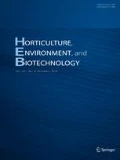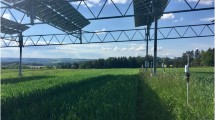Abstract
Deficient insolation conditions (DICs) frequently occur during the winter and early spring season in Korea and negatively affect crop growth. This study was conducted to investigate changes in the yields and qualities of strawberry fruits under DICs that result from an insufficient input of sunlight. To induce DIC, strawberry plants were treated with 40 or 70% shading by covering the plants with curtains during growth in a plastic greenhouse. The shaded plants were cultivated from March to May of 2012. When the strawberry plants were subjected to the shading treatments, their photosynthesis and fruit yields were significantly reduced. Although the mineral element and organic acid contents of the fruits were not affected by the shading treatments, the total nitrogen (T-N) of the stems and roots were noticeably reduced. Furthermore, the shading treatments of the plants also resulted in reductions in the sugar contents and total phenolics of the fruits. In parallel with these observations, the shading treatments were also found to decrease the antioxidant activities of the fruits as measured with the DPPH assay. We suggest that the DIC-induced losses of strawberry fruit yield resulted from the reduced photosynthetic performances of the plants that were caused by insufficient sunlight.
Similar content being viewed by others
Literature Cited
Bae, J.H., S.O. Yu, Y.M. Kim, S.U. Chon, B.W. Kim, and B.G. Heo. 2009. Physiological activity of methanol extracts from Ligularia fischeri and their hyperplasia inhibition activity of cancer cell. J. Bio-Environ. Cont. 18:67–73.
Blom-Zandstra, M. and J.E.M. Lampe. 1984. The role of nitrate in the osmoregulation of lettuce (Lactuca sativa L.) grown at different light intensities. J. Expt. Bot. 36:1043–1052.
Callejón-Ferre, A.J., F. Manzano-Agugliaro, M. Díaz-Pérez, A. Carreño-Ortega, and J. Pérez-Alonso. 2009. Effect of shading with aluminised screens on fruit production and quality in tomato (Solanum lycopersicum L.) under greenhouse conditions. Span. J. Agric. Res. 7:41–49.
Critchley, C. and R.M. Smillie. 1981. Leaf chlorophyll fluorescence as an indicator of high light stress (photoinhibition) in Cucumis sativus L. Austr. J. Plant Physiol. 8:133–141.
Dokoozlian, N.K., and W.M. Kliewer. 1996. Influence of light on grape berry growth and composition varies during fruit development. J. Amer. Soc. Hort. Sci. 121:869–874.
Fu, W., P. Li, Y. Wu, and J. Tang. 2012. Effects of different light intensities on anti-oxidative enzyme activity, quality and biomass in lettuce. Hort. Sci. 39:129–134.
Gill, S.S. and N. Tuteja. 2010. Reactive oxygen species and antioxidant machinery in abiotic stress tolerance in crop plants. Plant Physiol. Biochem. 48:909–930.
Gregoriou, K., K. Pontikis, and S. Vemmos. 2007. Effects of reduced irradiance on leaf morphology, photosynthetic capacity, and fruit yield in olive (Olea europaea L.). Photosynthetica 45:172–181.
Hijmans, R.J. 2003. The effect of climate change on global potato production. Amer. J. Potato Res. 80:271–280.
Jackson, M.L. 1973. Soil chemical analysis. Prentice Hall of India Pvt. Ltd., New Delhi, p. 111–192.
Kim, S.K., R.N. Bae, and C.H. Chun. 2011. Changes in bioactive compounds contents of ‘Maehyang’ and ‘Seolhyang’ strawberry fruits by UV light illumination. Kor. J. Hort. Sci. Technol. 29:172–180.
Kjeldahl, J. 1883. A new method for the determination of nitrogen in organic matter. Z. Anal. Chem. 22:366–382.
Li, P., S. Huo, W. Su, R. Lu, C. Deng, L. Liu, Y. Deng, N. Guo, G. Lu, and C. He. 2011. Free radical-scavenging capacity, antioxidant activity and phenolic content of Pouzolzia zeylanica. J. Serb. Chem. Soc. 76:709–717.
Lichtenthaler, H.K., C. Buschmann, M. Döll, H.J. Fietz, T. Bach, U. Meier, and U. Rahmsdorf. 1981. Photosynthetic activity, chloroplast ultrastructure, and leaf characteristics of high-light and low-light plants and of sun and shade leaves. Photosynth. Res. 2:115–141.
Marschner, H. and I. Cakmak. 1989. High light intensity enhances chlorosis and necrosis in leaves of zinc, potassium, and magnesium deficient bean (Phaseolus vulgaris) plants. J. Plant Physiol. 134:308–315.
Mensor, L.I., F.S. Menezes, G.G. Leitao, A.S. Reis, T. dos Santos, C.S. Goube, and S.G. Leitao. 2001. Screening of Brazillian plant extracts for antioxidant activity by the use of DPPH free radical method. Phytotherpy Res. 15:127–130.
Meyers, K.J., C.B. Watkins, M.P. Pritts, and R.H. Liu. 2003. Antioxidant and antiproliferative activities of strawberries. J. Agric. Food Chem. 51:6887–6892.
Ordidge, M., P. García-Macías, N.H. Battey, M.H. Gordon, P. Hadley, P. John, J.A. Lovegrove, E. Vysini, and A. Wagstaffe. 2010. Phenolic contents of lettuce, strawberry, raspberry, and blueberry crops cultivated under plastic films varying in ultraviolet transparency. Food Chem. 119:1224–1227.
Peng, S., J. Huang, J.E. Sheegy, R.C. Laza, R.M. Visperas, X. Zhong, G.S. Centeno, G.S. Khush, and K.G. Cassman. 2004. Rice yields decline with higher night temperature from global warming. Proc. Natl. Acad. Sci. USA. 101:9971–9975.
Slinkard, K. and V.L. Singleton. 1977. Total phenol analysis: Automation and comparison with manual methods. Amer. J. Enol. Vitic. 28:49–55.
Thaipong, K., U. Boonprakob, K. Crosby, L. Cisneros-Zevallos, and D.H. Byrne. 2006. Comparison of ABTS, DPPH, and ORAC assays for estimating antioxidant activity from guava fruit extracts. J. Food Compos. Anal. 19:669–675.
Treutter, D. 2005. Significance of flavonoids in plant resistance and enhancement of their biosynthesis. Plant Biol. 7:581–591.
Tulipani, S., B. Mezzetti, F. Capocasa, S. Bompadre, J. Beekwilder, C.H. Ric-devos, E. Capanoglu, A. Bovy, and M. Battino. 2008. Antioxidants, phenolic compounds, and nutritional quality of different strawberry genotypes. J. Agric. Food Chem. 56:696–704.
Vaast, P., B. Bertrand, J.J. Perriot, B. Guyot, and M. Génard. 2006. Fruit thinning and shade improve bean characteristics and beverage quality of coffee (Coffea arabica L.) under optimal conditions. J. Sci. Food Agric. 86:197–204.
Wurr, D.C.E., J.R. Fellows, and K. Phelps. 1996. Investigating trends in vegetable crop response to increasing temperature associated with climate change. Sci. Hort. 66:255–263.
Author information
Authors and Affiliations
Corresponding author
Rights and permissions
About this article
Cite this article
Choi, H.G., Moon, B.Y., Kang, N.J. et al. Yield loss and quality degradation of strawberry fruits cultivated under the deficient insolation conditions by shading. Hortic. Environ. Biotechnol. 55, 263–270 (2014). https://doi.org/10.1007/s13580-014-0039-0
Received:
Revised:
Accepted:
Published:
Issue Date:
DOI: https://doi.org/10.1007/s13580-014-0039-0




